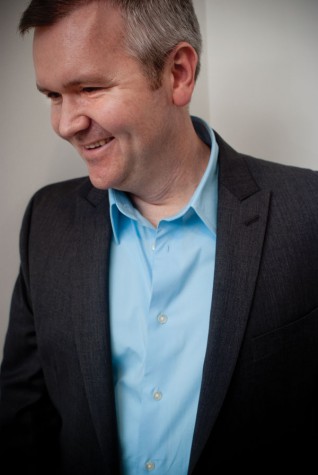A Fresh Vision
PROFILE-May 2010
by Suzette McAvoy
Photography Sean Alonzo Harris
George Kinghorn brings new vitality to the University of Maine Museum of Art.
Open, warm, and accessible”—these are the words that George Kinghorn, the recently appointed director and curator of the University of Maine Museum of Art in Bangor, uses to describe his “visitor-centered” approach to museum work. They also aptly describe Kinghorn himself. A Florida native, Kinghorn’s gracious manner and accent bear traces of his southern roots. After graduating from Savannah College of Art and Design and earning an MFA in painting from Michigan State University, he returned to his home state to teach studio art at Jacksonville University. At the same time, he started taking on independent curatorial work organizing exhibitions of contemporary art. His growing reputation as a savvy curator led to his being tapped to “oversee everything related to the art” when the city of Jacksonville approved construction of a new multimillion-dollar contemporary art museum in 1999.
Kinghorn spent nine “intensive” years at MOCA Jacksonville, and the strong series of high-profile exhibitions that he initiated—including Skin: Contemporary Views of the Body—are credited with establishing that institution’s national status. Today, the city of Jacksonville considers the contemporary museum the cornerstone of its historic downtown. “I’ve seen firsthand the impact a museum can have in the revitalization of a downtown,” says Kinghorn. “And I saw the same potential for UMMA and Bangor.” Seeking a “new challenge” to apply what he learned in Jacksonville, Kinghorn accepted the position at UMMA about a year and a half ago.
In his short tenure at the museum, Kinghorn has written a strategic plan, coordinated a complete rebranding, and overseen physical improvements to the galleries and lobby space. He has also dramatically increased the number of public programs and reinvigorated the changing exhibition series. Displays in the museum’s four galleries now rotate every three months, with one gallery reserved for revolving thematic selections from the museum’s permanent collection of more than 3,100 objects.
“The objective is to keep things fresh for our visitors,” he says, “instilling the idea that every time you come, you will see something new.” People are starting to take note. The museum’s attendance has more than doubled from previous years, and its reputation is rapidly growing throughout the Maine art community and beyond.
“Previously, the museum did very few public programs; now, we do a lot of public programs,” says Kinghorn. With activities like the popular Art@Noon gallery talks, student nights at the museum, and art camps for kids, he hopes to make UMMA “a place people of all ages will come to have a dialogue.” The new director has also “added a social element to the museum equation” with events like Fashion Forward and Summer Oasis—a gala dinner served under a tent in the outdoor sculpture court.
“As much as possible, I make myself available,” he says. “I’m extremely hands-on. I’m not a fellow who curates from the desk.” One of his most eagerly anticipated projects is the inaugural I-95 Triennial, a highly competitive juried exhibition that will take place every three years. The exhibition, which is the first of its kind in New England, is open to contemporary artists living along the I-95 corridor from Somerville, Massachusetts, to Houlton, Maine. The format of the exhibition reflects Kinghorn’s belief that the best way UMMA can serve Maine artists is “to put them in a larger context.”
One hundred and forty-four artists from Maine, New Hampshire, Massachusetts, and Rhode Island submitted work to this year’s show, from which forty-four were ultimately chosen by the jurors, including seventeen from Maine.
Two of Kinghorn’s former colleagues from Florida—John Bailly, a professor of art at Florida International University, and Wendy Wischer, a professor of art at Ringling School of Art and Design—assisted in the selection process.
“The goal for the jurors was to set a high standard for future triennials in regard to quality and the number of artists featured,” says Kinghorn. “We were paying really close attention to subtle connections between the works selected. We really wanted the show to have some cohesive moments, some common threads.” Several “common threads” identified by the jurors are color photography executed in an in-depth documentary style; art addressing issues of consumption, social concerns, and the fast-paced nature of contemporary culture; representational landscape paintings that reflect shifting light and changing environmental conditions; and contemporary abstractions displaying innovative approaches to methods and materials.
“Maine has such a tradition of biennials,” says Kinghorn, “it was important that we introduce a brand-new program.” The eighty-two works included in this year’s triennial represent the multitude of approaches to art making prevalent in contemporary art. “Being affiliated with the University, it is really important to our mission to expose students to what is happening in the larger art world,” says the director, “and to explore all the artistic mediums from painting to sculpture to new media.”
Kinghorn is as passionate about his adopted home as he is about the museum. He lives in downtown Bangor and loves that he can walk to work. “I absolutely adore Maine,” he says. “I gave up suburban sprawl and fast pace for the beautiful Maine landscape. How does it get any better than that!” Every free weekend, he says, “I’m out exploring, hiking in Acadia, Lily Bay, Bethel, all along the coast—I’ve already visited quite a lot.”
Reflecting on all that has been accomplished since he assumed leadership at UMMA, Kinghorn is quick to acknowledge the support of his “amazing staff” and of the local community. “We’ve really put great effort into getting the word out,” he says. “Our goal is to be a destination for people coming to Maine.”






